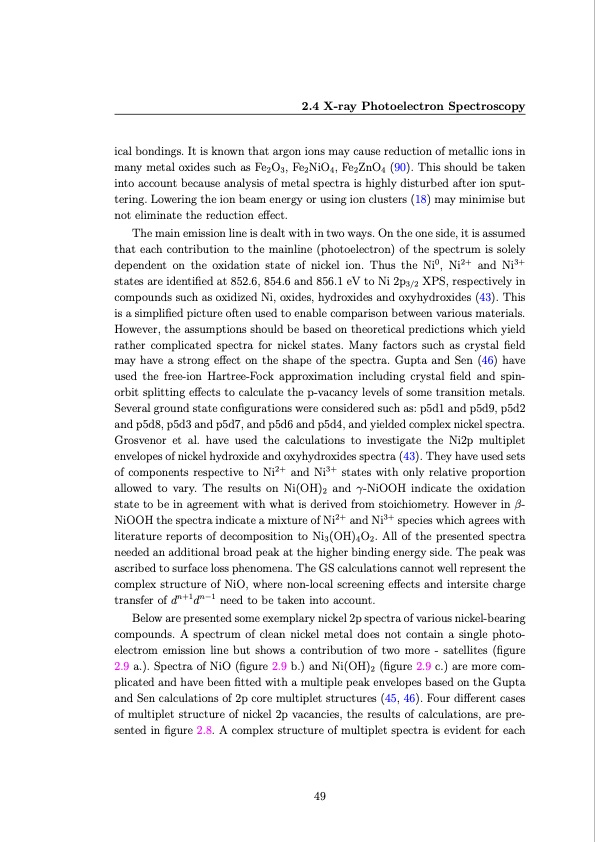
PDF Publication Title:
Text from PDF Page: 070
2.4 X-ray Photoelectron Spectroscopy ical bondings. It is known that argon ions may cause reduction of metallic ions in many metal oxides such as Fe2O3, Fe2NiO4, Fe2ZnO4 (90). This should be taken into account because analysis of metal spectra is highly disturbed after ion sput- tering. Lowering the ion beam energy or using ion clusters (18) may minimise but not eliminate the reduction effect. The main emission line is dealt with in two ways. On the one side, it is assumed that each contribution to the mainline (photoelectron) of the spectrum is solely dependent on the oxidation state of nickel ion. Thus the Ni0, Ni2+ and Ni3+ states are identified at 852.6, 854.6 and 856.1 eV to Ni 2p3/2 XPS, respectively in compounds such as oxidized Ni, oxides, hydroxides and oxyhydroxides (43). This is a simplified picture often used to enable comparison between various materials. However, the assumptions should be based on theoretical predictions which yield rather complicated spectra for nickel states. Many factors such as crystal field may have a strong effect on the shape of the spectra. Gupta and Sen (46) have used the free-ion Hartree-Fock approximation including crystal field and spin- orbit splitting effects to calculate the p-vacancy levels of some transition metals. Several ground state configurations were considered such as: p5d1 and p5d9, p5d2 and p5d8, p5d3 and p5d7, and p5d6 and p5d4, and yielded complex nickel spectra. Grosvenor et al. have used the calculations to investigate the Ni2p multiplet envelopes of nickel hydroxide and oxyhydroxides spectra (43). They have used sets of components respective to Ni2+ and Ni3+ states with only relative proportion allowed to vary. The results on Ni(OH)2 and γ-NiOOH indicate the oxidation state to be in agreement with what is derived from stoichiometry. However in β- NiOOH the spectra indicate a mixture of Ni2+ and Ni3+ species which agrees with literature reports of decomposition to Ni3(OH)4O2. All of the presented spectra needed an additional broad peak at the higher binding energy side. The peak was ascribed to surface loss phenomena. The GS calculations cannot well represent the complex structure of NiO, where non-local screening effects and intersite charge transfer of dn+1dn−1 need to be taken into account. Below are presented some exemplary nickel 2p spectra of various nickel-bearing compounds. A spectrum of clean nickel metal does not contain a single photo- electrom emission line but shows a contribution of two more - satellites (figure 2.9 a.). Spectra of NiO (figure 2.9 b.) and Ni(OH)2 (figure 2.9 c.) are more com- plicated and have been fitted with a multiple peak envelopes based on the Gupta and Sen calculations of 2p core multiplet structures (45, 46). Four different cases of multiplet structure of nickel 2p vacancies, the results of calculations, are pre- sented in figure 2.8. A complex structure of multiplet spectra is evident for each 49PDF Image | Investigation of metal-insulator transition in magnetron sputtered samarium nickelate thin films

PDF Search Title:
Investigation of metal-insulator transition in magnetron sputtered samarium nickelate thin filmsOriginal File Name Searched:
Bilewska_Investigation_of_metal_insulator_transition_in_magnetron_sputtered_samarium.pdfDIY PDF Search: Google It | Yahoo | Bing
Sulfur Deposition on Carbon Nanofibers using Supercritical CO2 Sulfur Deposition on Carbon Nanofibers using Supercritical CO2. Gamma sulfur also known as mother of pearl sulfur and nacreous sulfur... More Info
CO2 Organic Rankine Cycle Experimenter Platform The supercritical CO2 phase change system is both a heat pump and organic rankine cycle which can be used for those purposes and as a supercritical extractor for advanced subcritical and supercritical extraction technology. Uses include producing nanoparticles, precious metal CO2 extraction, lithium battery recycling, and other applications... More Info
| CONTACT TEL: 608-238-6001 Email: greg@infinityturbine.com | RSS | AMP |